Ensuring Research Results in
Manufacturable and Scalable Products
This is based on Section 3.9 of the 2020
edition of the DFM book.
Most research starts out just trying to prove an idea will work. And then what?
Once it “works” most managers and venture capitalists usually try to rush it into
production. And how well does that go?
The “Valley of Death” between concepts
and viable products
The official page of the Breakthrough Energy Coalition (led by the most famous
high-tech leaders) is quoted as saying
“Experience indicates that even the most
promising ideas face daunting
Commercialization.
challenges and a nearly
impassable Valley of Death between promising concept and viable product.
Neither government funding nor conventional private investment can bridge
this gap.”
The "Unsurpassable Mountain" after the
Valley of Death
And then, if the product does make it into production, it becomes obvious
that it costs too much. So then it is time for “cost reduction.” But this site
teaches all the reasons why cost reduction after design is so hard to do
especially if the cost metrics are primarily based on part cost, which is
typical. However, just trying consumes a
lot or resources and time while all the changes attempted (usually cheap parts)
cause quality problems, make it hard to
scale up to stable production, and may
also degrade functionality, all of which causes more firedrills to do even more
changes.
Why does this happen so much?
One reason is that some of the most popular “Phase/Gate” processes
actually skips from “Concept Testing” phase to “Prototype Testing” phase
without any product design phase in between!
Other "project management" oriented processes are just so rushed that there is not time to do good design.
This tells engineers that once a proof-of-principle or concept experiment
“works,” they should skip directly to building a prototype, which will cause
all the problems cited in the following article when products are designed
strictly for functionality. The white paper then shows solutions:
Concurrent Engineering for Challenging
Products.
If your company has such a dysfunctional "process," don't compromise your
research or wait for the process to be changed. Instead,
do everything on this page -- and this site -- in your project is
your own "micro-climate" as recommended at the end of this
page
The following methodologies show how to avoid this “valley of
death,”
Goals, strategies, and methodologies
T he ambition of the goal determines
how good the strategy must be and
those determine effective the methodology must be.
Research determines product
architecture
The definitive book on DFM (in Figure 1.1, right) says that
60% of cost is
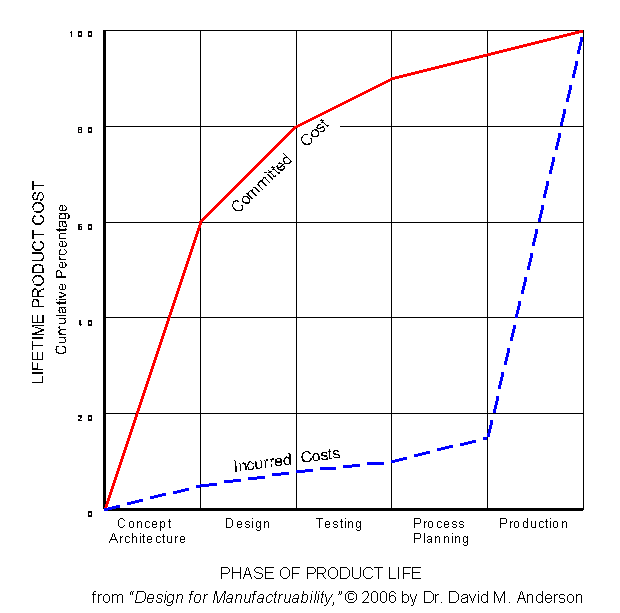
determined by the product architecture.
Proofs-of-principles or
even experiments can determine or imply the product
architecture or
limit its options.
As the graph shows, the only way to achieve ambitious cost
goals is through concept
breakthroughs. The article,
Designing Low Cost Products shows examples of cost
breakthroughs for two types of products:.
Electronics costs can be greatly reduced by specifying higher
levels of silicon integration, eliminating manual wiring,, modularization
(see below), combining circuit boards, and, if not possible, replacing all
circuit board connectors with flex layers between boards. Most of these will
require working early with vendor/partners, as discussed below and in
Section 3.1.14 of the 2020 DFM book.
Large Structures costs can be greatly reduced by replacing expensive
welded structures by more manufacturable assemblies of automatically
machined parts
that are assembled rigidly and
precisely by various DFM techniques. and in Section
9.6 of the 2020 DFM book.
Similarly, other important research, like concentrated solar power (CSP), would
need breakthrough concepts to solve the biggest cost challenges, like the
current need for hundreds of thousands of two-axis servo mechanisms to
reflect predictable sun rays to a stationary tower.
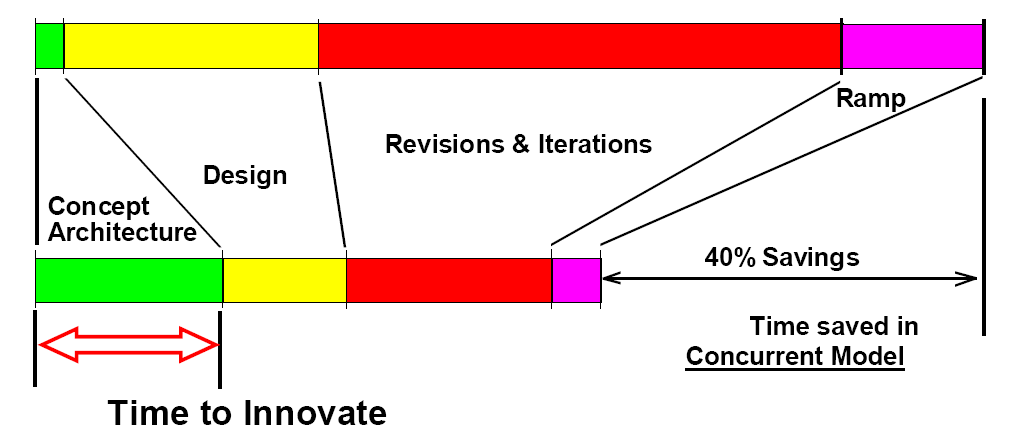
When to do Innovate
Figure 3.1 shows that
he time to do innovate is in the Concept/Architecture
phase shown in the recommend time-line, which is described at:
http://www.design4manufacturability.com/half-the-time.htm
What to do in the Research Stage or early product development:
Concept selection.
Don’t just jump at the first idea that comes to mind or whatever is easiest
to demonstrate, like Edison’s cylindrical phonograph, which he did launched
into production despite the fact that cylindrical records could not be stamped out like
manufacturable records.
Verify feasibility digitally
through simulations and analyses of:
- all aspects of functionality
- in all anticipated environments
- with specs that are all needed and achievable
- for the anticipated market variety
- with potential risks mitigated with tools like Failure Modes and
Effects Analysis, which can be used to compare competing concepts
- that can be built with readily available parts on widely available
processes with production skill levels (as discussed below and
Section 3.3.7)
- using readily available tolerances.
-
If necessary, scale back
non-essential functionality, specs, and product variety using
product platform design .
-
If necessary, re-formulate the
product concept to make the feasibility more viable.
-
If the above consideration narrows
the market, re-evaluate the business plan now before trying to build a non-manufacturable product.
-
ensure that the final product will
be manufacturable and scalable as recommended below. Always
remember:
There are many ways to
make something work;
There is only one that is the lowest cost.
Prioritization.
(Section 2.2.1 in the DFM
book) Focus
design efforts on what is most important to customers and get the rest off-the-shelf
(Section 5.18).
For Electronics don't
waste resources designing custom power-supplies.. Customers don't buy your
products for the power-supply. But they expect it to work all
the time. So, instead of wasting valuable time designing anything that is
hard to design and has nasty failure modes (smoke, fire, system failure),
specify proven off-the-shelf power supplies that have proven "track
records"
in your industry.
Voltage proliferation
should not force custom power supplies!
Off-the-Shelf Parts, discussed in
Section 5.18 in the DFM book
Premise :
Off-the-Shelf need to be done first,
before arbitrary decisions precluse their use@!
For Electronics. Similarly, don't consume valuable
resources -- and jeopardize quality -- designing routine electronic
functions that are readily quickly available off-the-shelf as modules,
sometimes called "single board computers," that have standard interfaces,
for instance, for:
- Processing: off-the-shelf processing boards are available
for every industry
- Memory, which can be increased with plug-in modules, even
in the field.
- Input/Output and communications, possibly based on USB,
Ethernet, HDMI, or VGA ports
- Motion control for actuators, motor axes, sensor inputs,
etc.
- Data acquisition and number
crunching.
Some off-the-shelf modules come with thoroughly debugged
software, which will free SW engineers to focus on your product's
unique software.
For Cabinetry and Industrial Equipment. Similarly,
don't waste
valuable resources designing anything that is readily available
off-the-shelf such as:
- all electronic cabinetry
and everything inside, as shown below:
- guards, doors, and shields
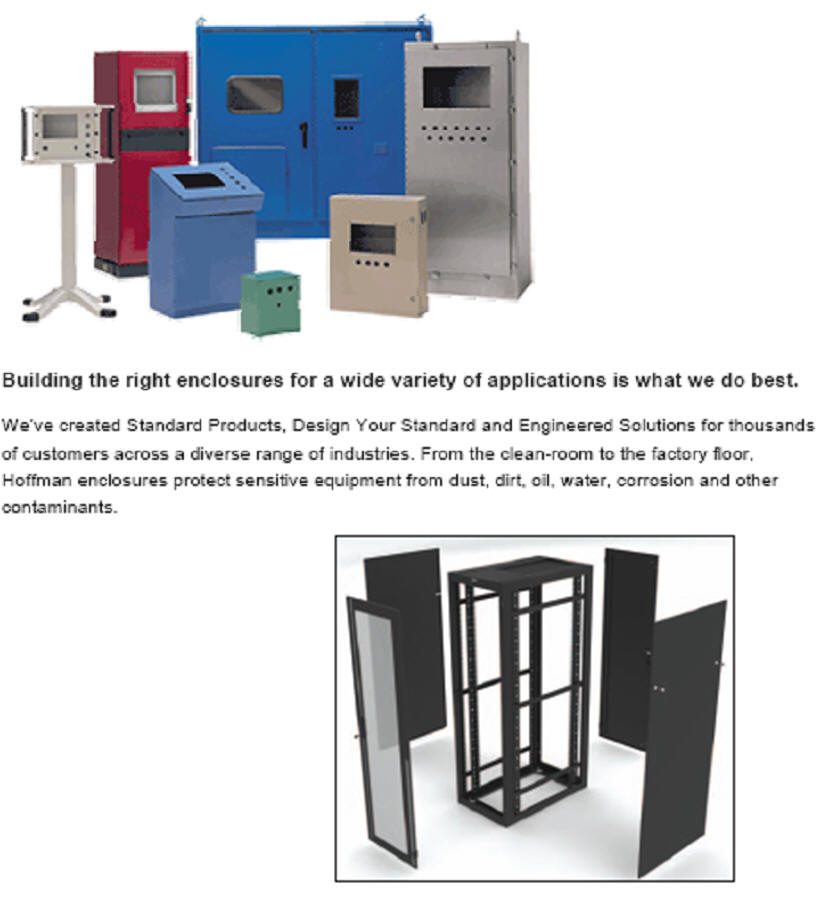
- stairs, railings, and platforms
- material handing devices, dispensers, conveyors,
even
palletizes
- mechanism controllers, actuators, and sensors
- cable assemblies using standard connectors and cables
- cabinets, enclosures, partitions, fans, doors, latches,
and
locks, which are available from catalogs or can
quickly be built
to-order in many standard sizes.
Two companies that have vast selections of electronic
cabinetry that can build them to-order:
Above right: image from Hoffman brand of Pentair:
Below, right: image from Cooper Industries:
Off-the-Shelf parts will actually cost less because the parts and their tooling is
already designed. If this is not immediately apparent, then "cost" must be
defined as total cost (Chapter 7) See
total cost web
page.
For Electronics, first consider OTS "single
board" computer" boards in OTS card cages
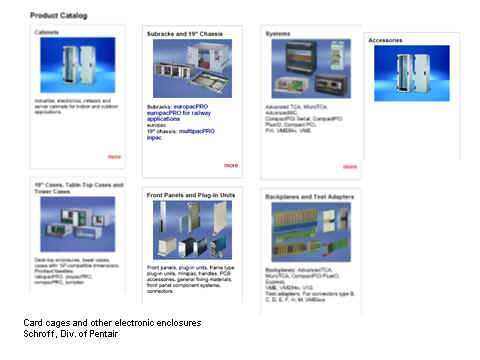
For most hardware parts,
instead of designing and build them, order them Built "to
order" in a few days by Masumi at http://us.misumi-ec.com/
which has several 3,000 page “catalogs” of parts that can be built to custom
dimensions and shipped in 6 days, without inventory. This
would be ideal for cables made of stand fittings and wires, made to custom
dimensions, instead of a "wiring harnesses" made by hand on plywood
sheets .
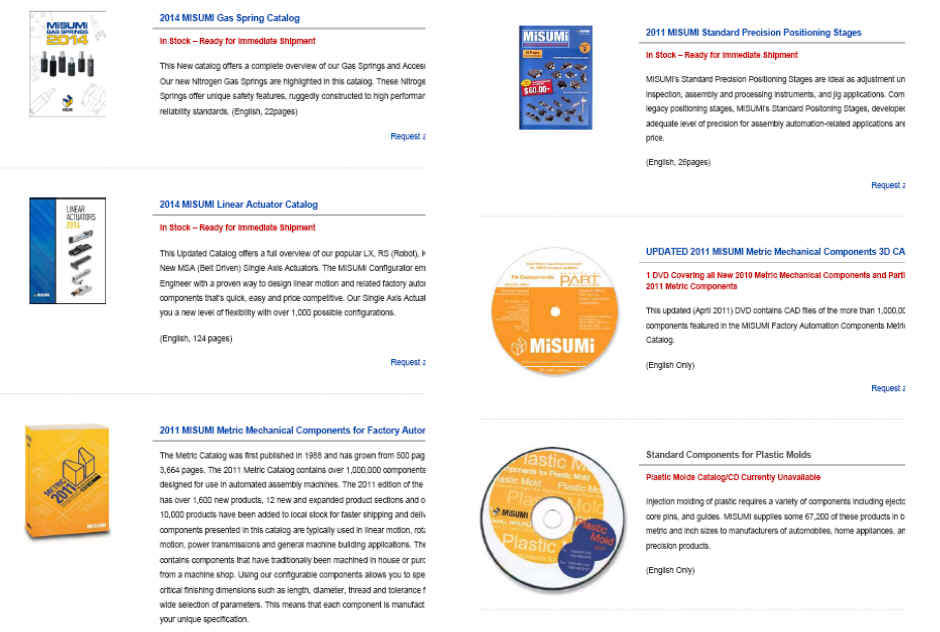
The paradox of product development is
that off-the-shelf parts must be chosen first
and then the product is literally designed around them.
AVAILABILITY, introduced
in first published treatment of Scalability in Section 4.8
For everything else that really needs to be designed,
project teams need to do the following:
Part & Material Availability:
The very first experiments or
proofs-of-principle must be based on readily available parts and materials.
If not done early, there may not be enough parts available for production, which
could result in shortages, which would require a full Commercialization
article.
Don not use scarce, expensive parts for research, just to ensure
early tests will "work."
Don not specify cheap parts (which also have availability
problems) just to get the part cost down, because (a) they may have to be
replaced later and (b) there are may better ways to avoid cost, like the
nine shown in the article on Half
Cost Product Development.
Do
not count on changing parts later for availability when going into production
because these difficult changes take time and resources to do, and, even worse,
introduce many new variables that degrade quality and even
compromise consistent performance
Parts from Bins or Lists. Do not pick parts from just any
part bin in the factory or any entry on an "approved parts list" because
most of those are still there for legacy parts, which have obsolescence
challenges. And even if you pick a part value that is used on
current products, you may pick a duplicate part number, which may
not be as available as the most common part number.
Proven parts. An important way to minimize risk and assure
success is to specify only proven parts,
materials, and processes
that have their own “track records” that can be the basis for
reliability calculations
Inherently scarce parts. Do not base research on “rare Earth” elements
or single-source suppliers or availability only from one country or region that
may be prone to wars, instability, epidemics, or weather dostasters.
Also, t fso
avoid resistance later, avoid materials that have regulatory challenges or
could be toxic to people or the
environment.
Rather, select parts from standard parts lists (Section
5.8 in the DFM book) that
have been approved for new product designs.
If not already done, you will have to create standard parts lists for
your research hardware,
especially for any that may have availability problems.
Rescue Parts. Do not tune a design or
rescue something that is not working with unusual parts with many
increment
values. like shims (often done in .001" increments), resistors
(from racks of 1 ohm increments), crystals (with whatever frequency that
makes it work), coils (with whatever number of windings that makes it work),
obsolete component packaging (e.g. lead-through parts when products are
now manufactured on Surface Mount Technology equipment), or any other
unusual parts or obsolete technologies.
Rather, make your design robust enough to work with
readily available standard parts
that can be automatically assembled and soldered.
Questionable Sources. Do not pick parts from hobby
shops, hobby part sites, lab equipment catalogs (that have vast
inventories of non-production parts), or surplus warehouses (which is
the basis of many silicon valley legends).
Rather, work with your Purchasing Agents to find good
parts from their best suppliers
If you can’t make it
work with easily available parts from good suppliers, the research may not be feasible.
Achievable Tolerances
discussed in Section 10.2 in the DFM book.
The very first experiments or proofs-of-principle must be based on tolerances that
are routinely achievable in production environments. If not done right,
products will always be unnecessarily too costly and hard to build because
tolerances are
so hard to loosen later. The root cause of this is the common
temptation to do whatever it takes to make one proof-of
principle “work,” so there is pressure to specify tight-tolerance parts.
This brings designers 4 immediate acclaim, but will doom the product’s chances for cost effective
production.
Optics and Systems Needing Precise Alignment. Most research
efforts for optics and lasers prove it will work on a precision ground
marble slab with precision mounting blocks for all the mirrors, lenses, and
sensors,
which are tediously adjusted by skilled technicians until it "works." If that is just
thrown over the wall to manufacturing, the "product" would have (a) many
tight tolerances specified for all key dimensions and (b) onerous, slow,
difficult, and costly alignment procedures with high skill demands (next
point).
Rather, the architecture should be optimized to provide
the necessary tolerances at the least cost with the least skill demands.
This can be accomplished with Guideline P14 (in Section 9.2 in the
DFM book), which shows how to fabricate many
dimensions at tight tolerances by laying out the architecture so that
all dimensions can be machined on one part in one setup
(one chucking) on a multi-axis machine tool, like the first illustration
on the Flexible Manufacturing article at:
http://www.build-to-order-consulting.om/flex-mfg.htm .
However, this must be optimized in the architecture stage to ensure all
the critical dimensions are on one part and dimensioned properly.
If you can’t make it
work with achievable tolerances,, the research may not be feasible.
Skill Demands
discussed in DFM boo Section
3.3.7. Similarly, the other half of doing "whatever it takes” is to use highly skilled
technicians, who pride themselves at being able to make anything work, even unmanufacturable designs. The
result is that such designs will have low quality, slow throughput, and may not
work consistently without the original skill levels, which would keep cost high.
For example, instead of designing the usual hard-to-build
welded machine frames that
have high skill demands, design assemblies of parts that are automatically
machined on CNC machine tools and then assembled precisely and rigidly by
various DFM techniques, as described at the following page. An added bonus
is that such a frame can be designed to be a back-ward compatible "drop in"
replacement for current products. If this is done first,
it can actually help fund the research and then become the basis for
the proof-of-principle. All of this is described at:
http://www.design4manufacturability.com/steel-reduction-workshop.htm , which
has many illustrated examples.
In an early November,
2021 FlightGolbal cited Salfan
saying:
"Skilled workers may be in short supply"
Widely Available Processing.
The very first experiments or proofs-of-principle must be based on widely
available processing equipment, like ordinary CNC machine tools. Needing
unusual, extra precise, or custom-made machine tools or processing equipment
will raise costs, show deliveries, and even hamper scalability. At the
other end of the extreme, don't have research where labor is predominantly
manual, unskilled, or migrant.
If you can only build it
on ordinary machine tools, the research may not be feasible.
Concurrent R&D.
Concurrent Engineering should start
early to ensure that research will be manufacturable and scalable (Chapter 2). The
web-page on Scalability shows how to use
Concurrent Engineering to design scalable products. The essence of
Concurrent Engineering should be working early with Manufacturing and Purchasing
people to avoid the all the problems that come from designing in isolation
and "throwing it over the wall" to the factory, which is discouraged at
best-practice companies:
Paul Horn, who oversees research at IBM
says: “Everything we do is aimed at avoiding a ‘handoff’ -- there is no
‘technology transfer.’ It is a bad phrase at IBM.” Research teams stay with
their ideas all the way through to manufacturing.".
Independent research labs in the government or universities should
pre-select the best manufacturing company for the same reasons that the
best of the best practice companies use pre-selecting
vendor/partnerships when a
manufacturer needs to outsource custom parts. See Chapter 10,
"Fully Integrate Suppliers into the Product
Development System," in the book, The Toyota Product
Development System (Morgan and Liker, Productivity Press, 2006).
Both the linked article and this book prove that vendor/partnerships result
in less total cost and scale up faster than starting the design work alone
and then sending that out to the
low-bidder.
Companies endeavoring to do effective Scalable research or
early product development steps must practice
Lean Production, which section 4.1 defines as ". eliminating many types
of waste such as setup, excess inventory, . . . ," with most of the
book’s 10 times cost savings come from inventory categories! (in the "Half
Cost Product Development" in Section
3,8).
Other practices and policies unacceptable for
Manufacturable Research are
the 12 more counter-productive practices and policies warned against in Section
11.5 in the2020 DFM book. The on-line
version is at: http://design4manufacturability.com/counterproductive.htm
Don’t offshore
production because, in addition to
not saving total cost , offshoring will thwart concurrent engineering
if factories are not even working at the same time-zone. This means that your
engineers must design everything in isolation, know how to design for
manufacturability alone, and throw perfect and complete drawings over the ocean and
then the Contract Manufacturer will “build-to-print” and then deal withthe
potential of travel disruptions both ways.
Conclusions on Time and Resources:
Doing all of the above may take a little more time and effort up-front, but will
avoid many more times the months, and resource-hours later trying to fix the
design with changes after so much is "cast in concrete" and
boxed-into-many-corners.
Conclusions on Cost. If
research is done "on the cheap" with inadequate "seed money" or trying to
getting venture capital funding with anything that "works," the result will most
likely be lost investments at the
“Valley of Death” quoted above.
Implementation at manufacturing companies: Even before this is incorporated into the
company product development process, all of this can be implemented
immediately by a project in its own microclimate, (introduced in
Section 11.7.2) in project "obeya" rooms (Section 2.7.2 in
the DFM book). Manufacturing companies working
early with research labs can work early together in a project room at either the
research lab or the manufacturing company. In fact, Toyota uses the
traveling Obeya to "move downstream to the plant as the program moves
downstream" (page 263 in The Toyota Product Development System).
Consequence of not doing this:.
If all the above
is not done proactively in the research phase, then un-manufacturable
proofs-of-principle or prototypes will then have to be
Commercialization.
which preserves the research "crown jewels"
and then re-designs everything around them for manufacturability, as shown at
Commercialization
See a list of Commercialization clients listed
near the bottom of:
http://www.design4manufacturability.com/clients.htm
The very first step may be to start with a few
hours of thought-leader
consulting
to help formulate strategies and implementation
planning.
In customized seminars
and webinars, these principles are presented in the context of your
company amongst designers implementers, and managers, who can all discuss
feasibility and, at least, explore possible implementation steps
In
customized workshops, brainstorming sessions
apply these methodologies to your most relevant products, operations, and sup
Here
is an email you can use to send this information around:
Subject: Useful web article on easy ways to make Research
more manufacturable
to:
all:
I just found a web article that can show us easy ways to
make our own own esearch inherently more manufacturable, without any
outside help, at: www.design4manufacturability.con/research.htm.
After first emphasizing that the concept/architecture
determines 60% of cost if done right and that will cut the time to stable
production in half, the rest of the article presents, simple, "low hanging
fruit" steps that can be easily done in the research stage by:
- Basing routine electronics on proven, off-he-shelf
modules, such as power-supplies and printed circuit boards.
- Basing cabinetry on enormous catalogs
which will guarantee low-cost and availability if this is considered
before arbitrary decisions preclude their use.
- To ensure that the product does not have
excessively high tolerance, skill, and machine tool demands, make sure
Research groups do not specify those just to make the breadboard will
"work" at the big demo.
The article concludes by warning that if those steps are
not done in the research stage, (a) product will be hard to launch
successfully, or (b) it will need to be Commercializationby an extra phase by
doing everything specified at at this page.
Would you like to enquire further?
copyright ©
2024 by
David M. Anderson
Book-length web-site on Half Cost Products:
www.HalfCostProducts.com
[DFM Consulting]
[DFM
Seminars]
[DFM Books] [Credentials]
[Clients] [Site Map]
[DFM article]
[Half Cost Products site] [Standardization
article] [Mass Customization article]
[BTO article] [Rationalization
article]
|
